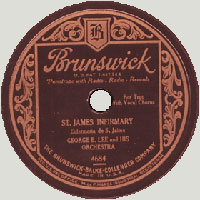
George E. Lee Band, 1929-35
Early in 1929, Jesse Stone joined the George E. Lee band. Stone's masterful arrangements and compositions vastly improved the Lee band, bringing it up to par with Bennie Moten's band. On Sunday, April 28th the Lee band bested the Moten band in a "battle of the bands" at the Frog Hop in St. Joseph, Missouri. Lee's victory called into question Moten's regional dominance and the defeat compelled Moten to bring aboard Eddie Durham and Count Basie, later that year, to modernize and polish the band.
In November, 1929, the Lee band recorded six selections for the Brunswick label, including ![]() Saint James Infirmary. Louis Armstrong had recorded an up-tempo version of "Saint James Infirmary" a year earlier, but it failed to catch on with the record-buying public. Lee's slower-tempo version better matched the solemn lyrics describing a gambler meditating on his own mortality while viewing his dead sweetheart's body in Saint James Infirmary. The record sold well locally, but Brunswick did not promote it nationally in the advent of the Great Depression. Cab Calloway's cover of Lee's version of "Saint James Infirmary," recorded the next year, created a national sensation.
Saint James Infirmary. Louis Armstrong had recorded an up-tempo version of "Saint James Infirmary" a year earlier, but it failed to catch on with the record-buying public. Lee's slower-tempo version better matched the solemn lyrics describing a gambler meditating on his own mortality while viewing his dead sweetheart's body in Saint James Infirmary. The record sold well locally, but Brunswick did not promote it nationally in the advent of the Great Depression. Cab Calloway's cover of Lee's version of "Saint James Infirmary," recorded the next year, created a national sensation.
In between one night stands at Paseo Hall, the Lee band toured the territories, ranging widely from the Gulf coast to the Northwest. The constant touring took its toll on the band. In February, 1932, Jesse Stone, drummer Baby Lovett, alto saxophonist Herman Walder and trumpeter Richard Smith deserted the Lee band to join the newly formed ![]() Thamon Hayes band. In 1933, Lee joined forces with Bennie Moten, forming the Lee-Moten Band for an engagement at the
Thamon Hayes band. In 1933, Lee joined forces with Bennie Moten, forming the Lee-Moten Band for an engagement at the ![]() Harlem Nightclub on the site of the former Paseo Hall. In 1934, Lee's sister
Harlem Nightclub on the site of the former Paseo Hall. In 1934, Lee's sister ![]() Julia left the band and launched a long-term engagement at
Julia left the band and launched a long-term engagement at ![]() Milton's, a popular club on Troost Avenue. The next year, Lee disbanded his big band and freelanced on 12th and 18th Streets. From time to time, Lee assembled big bands for special engagements, but he never achieved the success he enjoyed with his band of the late 1920s and early 1930s.
Milton's, a popular club on Troost Avenue. The next year, Lee disbanded his big band and freelanced on 12th and 18th Streets. From time to time, Lee assembled big bands for special engagements, but he never achieved the success he enjoyed with his band of the late 1920s and early 1930s.


